Seaside resorts out-of-season have always appealed to me. Following my enjoyable trip to Blackpool on 9th February 2019 (described here) I decided, two weeks later with a fairly promising weather forecast, to re-visit the North Wales coast. Partly, I was interested to see how the railway had changed since my last trip along the line just over three years earlier (described here).
Getting there
After enduring a very cramped and unattractive station building for well-over 50 years, construction work has started on the new station for Wolverhampton.

Wolverhampton Station: Construction work on new station.
Having travelled to Wolverhampton from my village by the first bus, the first train I was able to catch, which would get me as far as Crewe, was the Liverpool service from platform 2 at 09:20. The 4-car Electric Multiple Unit is allowed 35 minutes to Crewe with just one stop at Stafford. This part of the trip would be controlled by two control areas at Rugby Railway Operating Centre - control code 'WS' as far as Stafford and control code 'SC' on to Basford Hall Junction on the approach to Crewe.
As we sped towards Crewe, I was able to follow our journey in real time using my smartphone and the signalling diagrams provided by 'Railcam.UK' (I've written a short explanatory post here).

Llandudno by Rail: The Railcam.UK live diagram shows 1F36 passing Madeley Jn. on the Down Slow as my train (1F36) actually passes Madeley Jn. The diagram also confirms that the signal behind us has been replaced to 'red' to protect the train.
Click here for a larger image.
At Crewe, I took more pictures of North Junction and its elderly colour light signals whilst waiting for the 'shuttle' from Chester to arrive.
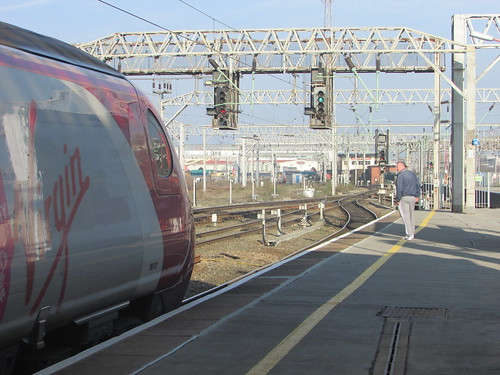
Crewe station: View from platform 11 as a 'Pendolino' departs for Glasgow.
The Chester train was scheduled to leave North end bay platform 10 at 10:26 but, in a little game that I've seen played before here, just before the service arrived, the platform was changed to adjacent platform 9 so that the waiting passengers has to troop around to the next platform. Everybody boarded and we set off, under the control of what was originally intended to be the 'temporary' Signalling Centre at Crewe.
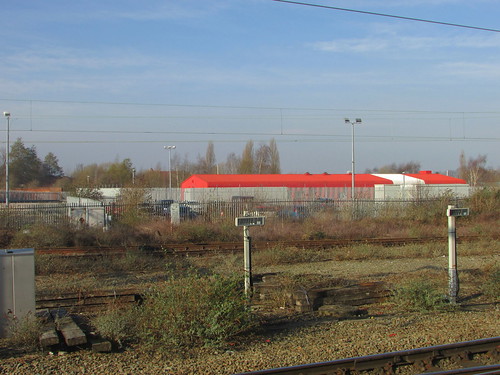
Crewe Signalling Centre viewed from platform 9.
As we left Crewe, I amused myself by taking a picture of my smartphone displaying video of my train's departure streamed from the 'Railcam.UK' site by selecting one of the four cameras within Crewe Heritage Centre which monitor Crewe North Junction.
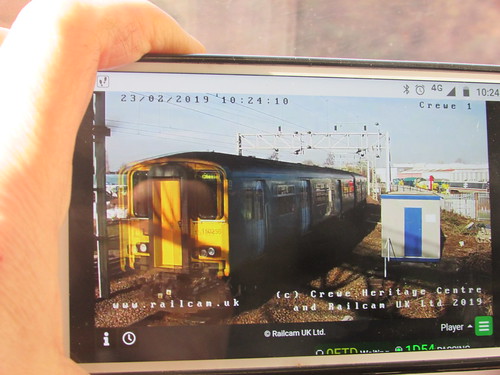
Railcam.UK live camera at Crewe North Jn. showing Class 150 leaving for Chester, as viewed on my mobile from the front coach!
We soon passed Crewe Steel Works Box with colour light signals controlled from an LMS Standard lever frame and batted along to Chester. Beeston Castle retains its mechanical signal box and a few semaphore signals but at least one signal has been converted to a single-head LED colour light.
We arrived at Chester, on time, terminating at the Up & Down platform 3a, under the control of Chester Power Box. Enquiry confirmed that my connection to Llandudno would depart from platform 4, meaning I had to go "up and over" the footbridge. Halfway up the steps, there was a fairly inaudible announcement and the people who'd been climbing alongside me turned round. It appeared that Crewe is not the only station which likes to play 'musical platforms'. Our departure would now be from platform 3b, the opposite end of the platform at which I'd arrived. Whilst waiting for my train, I noted that most of the colour light running signals were now single-head LED types. Checking my pictures later, I confirmed that in February 2016 (see post here) these signals had been conventional 3-aspect types. The 3-coach Class 175 arrived via the Down Main (through) line so as to pass the Class 150 preparing to return to Crewe and then took the crossover halfway along the platform into platform 3b.
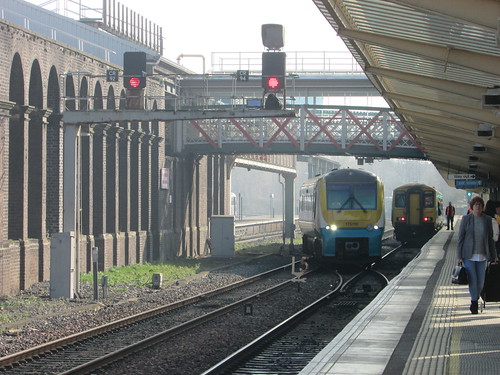
Chester: View from platform 3 looking towards Crewe, showing the Class 175 arriving from Manchester Airport which would take me to Llandudno.
We were soon on our way again, through the sandstone cuttings and tunnels as we left the city.

Chester: East end of Northgate Street Tunnels in 2014.
Then we crossed the River Dee on the Roodee Viaduct and passed through Saltney Junction where the former GWR line branched to our left. The junction is now remotely controlled from Chester Power Signal Box, as is the North Wales Line through Shotton Low Level. For many years, the funny-looking 2-storey prefabricated signal box at Rockcliffe Hall was the fringe box to Chester Power Signal Box but that's gone and this location forms the start of control area 'FH' (Flint-Holyhead, I presumed) controlled from the Railway Operating Centre at Manchester.
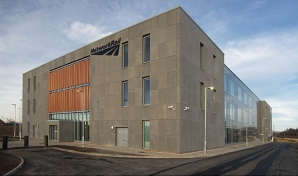
Manchester Railway Operating Centre, Ashburys (Photo: Network Rail).
We passed under the A548 dual carriageway which crosses the railway on a long skew concrete bridge before catching a glimpse of Connah's Quay Power Station on our right. Once through the short Rockliffe Hall Tunnel, our train slowed on the approach to our stop at Flint. There are now crossovers between the Up and Down approaching Flint and the LED colour light signals have been arranged to allow bi-directional working. At Holywell Junction, the extensive sidings have been taken out of use although the L&NWR signal box with its 54-lever tumbler interlocking frame which stands between Up and Down lines is still intact. A little further on, the TSS 'Duke of Lancaster' still sits, beached and abandoned, on the seaward side. The hull has been repainted black, covering the graffiti 'artwork' I'd noted on earlier trips but the air of sad desolation is still apparent.
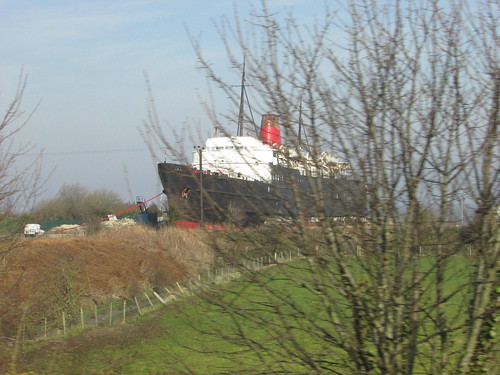
Llandudno by Rail: TSS 'Duke of Lancaster'.
Re-signalling has also taken Mostyn signal box out of use but, like Holywell Junction, the structure remains. The various sidings have been modernised. There's now a bi-directional loop with headshunts each end on the seaward side of the line accessible in both directions. A spur from this loop serves Mostyn Docks. On the return journey I snatched a (not very good) picture of part of the signal gantry at the Chester end of the loop.
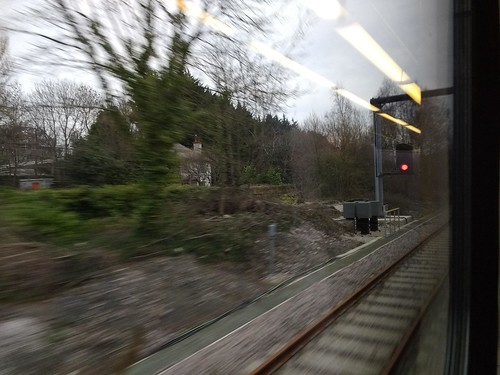
By Rail to Llandudno: Signal gantry east of Mostyn with signal FH6038 (Loop to Main) cantilevered from upright and four equipment housings.
The line then runs along the sea wall before curving away from the shore at Point of Ayr with its Gas Terminal.
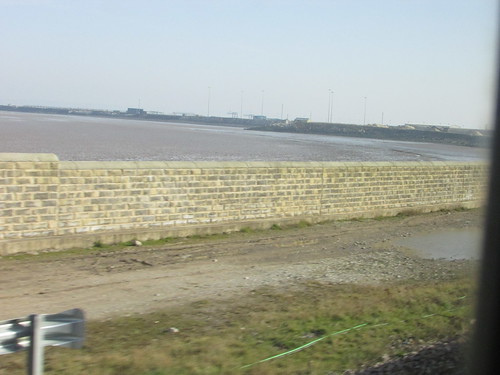
Llandudno by Rail: The Seawall at Mostyn with Mostyn Docks in the background.
Talacre signal box is now out of use but still stands where it once controlled the sidings to Point of Ayr Colliery before that closed and the Gas Terminal was built. We made our stop at Prestatyn (where I failed to check whether the now-disused signalbox was intact) before continuing to Rhyl, where the now-redundant Rhyl No. 1 signal box remains in reasonable external condition, although ivy is now climbing the front elevation.

Llandudno by Rail: Rhyl No. 1 signal box, now out-of-use.
As at Flint, there are now crossovers between the Up and Down approaching Rhyl from Chester and the LED colour light signals have been arranged to allow bi-directional working. For example, the route indicator atop signal FH6084 is for movements in an Up direction over what is normally the Down line.
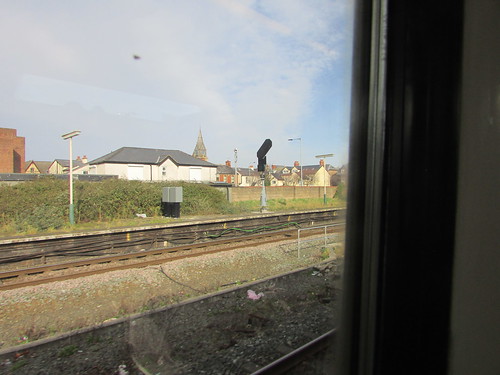
Llandudno by Rail: Signal FH6084 (single-head LED colour light with route indicator on substantial post), Up Main leaving Rhyl.
Parts of the station were covered in scaffolding and a number of workman in orange overalls and hard hats were around.

Llandudno by Rail: Rhyl station Up platform. Note scaffolding above footbridge and netting above buildings.
Leaving Rhyl, we passed Rhyl No. 2 signal box which was abolished some time ago. It survives in reasonable condition with the windows painted-out. I had understood that both Rhyl No. 1 and Rhyl No. 2 (together with Mostyn signal box) were listed buildings but, on checking the Historic England database on my return I was unable to confirm whether that's correct.

Llandudno by Rail: Rhyl No. 2 signal box, taken out of use some time ago.
At Abergele, there's yet another retired signal box but the down through line which, on previous trips was controlled by this signal box, has been taken out. This is the present limit of control from the Railway Operating Centre at Manchester.
Llandudno Junction signal box now took control of our train through Colwyn Bay and 'The Junction', before handing over to Deganwy signal box.

Llandudno by Rail: Llandudno Junction signal box. Note external stairs at both ends of box and Relocatable Equipment Building.
The L&NWR manual signal box at Deganwy, like Beeston Castle, retains some tubular upper quadrant semaphore signals. Deganwy's signals, following modern practice, have rectangular identification plates carrying the signal box code ('DY') followed by the lever number. Even the Up independent distant signal carries an identification plate. Some time ago, the level crossing gates on Marine Crescent outside the signal box which had been worked mechanically from the were converted to lifting barriers. With the development of Deganwy Quay as a Marina and residential area, a lifting barrier level crossing has also been provided at the Llandudno Junction end of Deganwy station.
We were soon entering the much-simplified layout of Llandudno station, still controlled from its L&NWR-pattern manual signal box but with so much external alteration that its parentage is obscured.
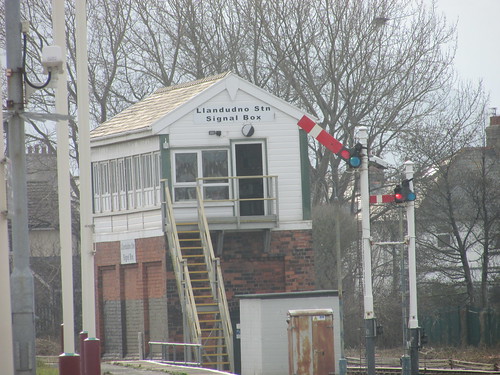
Llandudno by Rail: Llandudno Station Signal Box.
Around Llandudno
Although it had been sunny on the earlier part of the journey, it was dull in Llandudno but with a very gentle breeze and local temperature (according to the internet) of 16 degrees Celsius. I immediately headed for the shore, passing the appropriately named North Western Gardens where I crossed Mostyn Street and followed Vaughan Street to the Promenade.
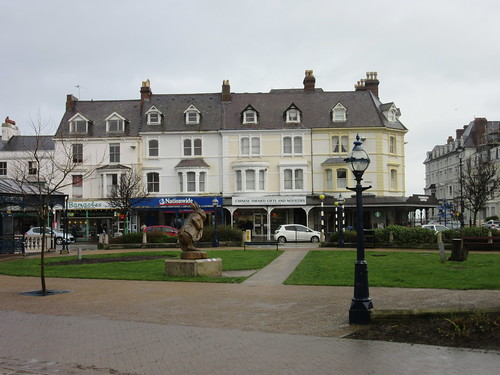
Llandudno: View across North Western Gardens showing the canopied shops in Mostyn Street.
It was very pleasant on the Promenade and I was surprised at how many people were about, some quite lightly-dressed. The advantage of the sea mist was that the off-shore wind farms were virtually invisible. The temptations of the Terrace Restaurant at the Imperial Hotel proved too strong but, by the time I'd consumed a generous portion of cream of celeriac soup with fresh rolls and butter, I only needed a pot of English Breakfast Tea to set me up for a walk along the front.
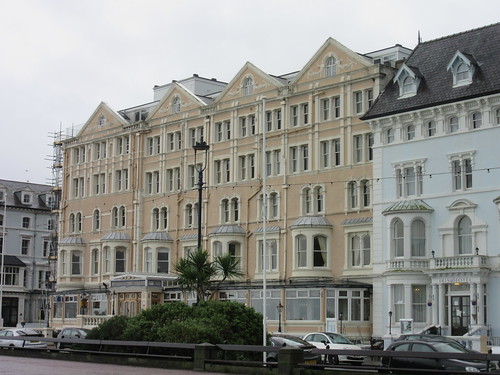
Llandudno: The Imperial Hotel pictured in 2014.
At the St. George's Hotel, I turned left into St. George's Place and continued across Mostyn Street into Lloyd Street. Here, I spent a pleasant half-hour browsing in an Antique Fair being held in the Town Hall before continuing north along Mostyn Street looking at shops. I made my way back to the shore near the Cenotaph. Llandudno is built on a peninsula which ends in the massive bulk of the Great Orme. The main promenade faces north into the Irish Sea but, just 1 kilometre away, the less-developed West Shore on the other side of the peninsula offers alternative views which I didn't have time to sample on this occasion. The main beach is mainly shingle but, near the Cenotaph there's a small sandy area of shore exposed (except at high tide) which I briefly explored before continuing along the promenade back towards the Imperial Hotel, where I left the promenade and made my way back to the station.

Llandudno: The Cenotaph and North Parade, looking towards the Great Orme
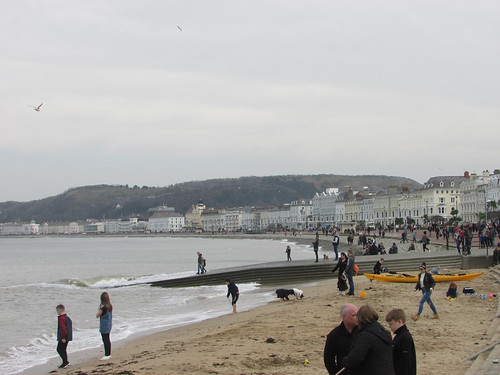
Llandudno: View of Promenade looking away from the Great Orme.
Getting back
I had left a few minutes spare to study the station re-development which, in general, I approve of. I admired the careful treatment of the preserved gates and ticket barriers originally provided by the L.M.S. Note the interlaced 'L M & S'. Contrast this with the rebuilt end wall of the overall roof with its ugly welded truss and the insensitive way the truss is jointed to the brick wall. It may be functional but did it have to be so brutal?

Llandudno Station: The LMS Ticket Barriers at the entrance to platform 2 and welded truss supporting the rebuilt end wall of the overall roof.
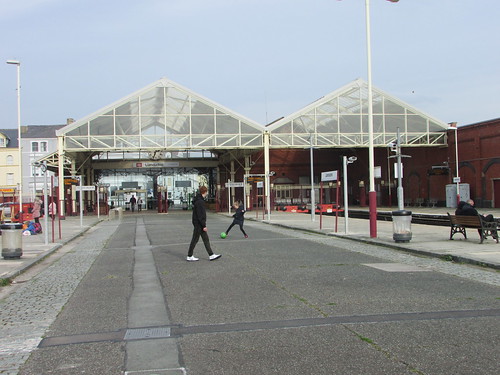
Llandudno Station: View from the Carriage Road showing overall roof with modern glazed end wall supported by welded trusses.
A 3-car Class 175 Diesel Multiple Unit quietly arrived in platform 3 and, almost immediately, the signalman cleared the platform starting signal for the train to depart. Arriving passengers got off, departing passengers boarded and the driver and guard 'changed ends' so that we departed within about 5 minutes of the train's arrival. As we passed the signal gantry, I took another picture.
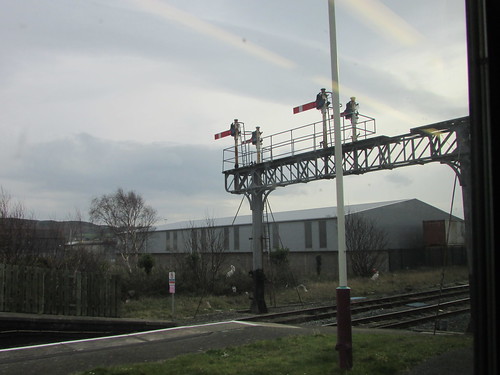
Llandudno by Rail: Platform starting signals for platforms 1 & 2 at Llandudno (Pratt Truss with four tubular upper quadrant semaphores).
The return journey was a mirror-image of the outward trip. The first train took me as far as Chester, platform 3b. My onward Crewe service (a 2-car Class 150) was waiting in platform 3a and left almost immediately. I'm not sure what the connection at Crewe was supposed to be but we arrived in platform 9 and, by the time I'd walked to the adjacent platform 6, a 4-car Electric Multiple Unit on the Liverpool-Birmingham service was snaking over the crossovers from the Up Fast into Platform 6. Within a few minutes, I was on my way back to Wolverhampton.
I took a few, rather indifferent, photographs during the return but I'm afraid I was tiring and I find photography from modern trains with double-glazed tinted windows and harsh reflections from internal carriage lighting rarely satisfactory (except, perhaps, to clarify a technical issue thrown up by another picture).
Related posts on this website
There are a number of posts about the North Wales Line and Llandudno:-
A Trip to the Seaside (Part 1)
Journey 26-Nov-2011
A Trip to the Seaside (Part 2)
Journey 26-Nov-2011
Trip to Holyhead (Part 1: Crewe to Llandudno)
Journey 25-Jan-2014
The Holyhead to Crewe Railway Line
(posted Feb 2014)
Llandudno
Journey 30-Aug-2014 (by road)
Llandudno Railway Station
(posted Dec 2014)
Return to Llandudno
Journey 6-Feb-2016
There's also an index of posts describing some of my railway journeys exploring Britain. I'm afraid they're not very adventurous trips, with many destinations repeated but you can find the list here.
Book References
For convenience, the bibliography which appeared in earlier posts about the North Wales Line is repeated here:-
[1] 'Railways to the Coast' by Michael H. C. Baker, published by Patrick Stephens (ISBN 1-85260-058-6).
[2] 'Recollections of a Steam Era (1950-1966)' by H. Rogers Jones, published by David Rogers Jones (ISBN: 0-9539720-0-03).
[3] 'LMS Branch Lines in North Wales Volume 1' by W. G. Rear, published by Wild Swan Publications (ISBN 0 906867 37 1).
[4] 'An Historical Survey of Selected LMS Stations' by Dr. R. Preston Hendry & R. Powell Hendry, published by Oxford Publishing Co. (ISBN 0-86093-330-X).
[5] 'A Pictorial Record of L.M.S. Architecture' by V. R. Anderson and G. K. Fox, published by Oxford Publishing Co. (SBN 86093 083 1).
[6] 'A Historical Survey of Chester to Holyhead Railway Track Layouts and Illustrations' by V. R. Anderson and G. K. Fox, published by Oxford Publishing Co. (ISBN 0 86093 216 8).
[7] 'A Regional History of the Railways of Great Britain: Volume 11 North and Mid Wales by Peter E Baughan, published by David & Charles (ISBN 0-9153-7850-3).
My pictures
Where necessary, clicking on an image above will display an 'uncropped' view or, alternately, pictures may be selected, viewed or downloaded, in various sizes, from the albums below:-
In making my (often quite poor) pictures available on the internet, I have divided them into various albums each covering a roughly-defined geographical area. Within each album, photographs are normally arranged by date taken. Thus, by searching through the appropriate album, you can find changes through time. So, my trip to Llandudno added pictures to a number of albums as we moved through various areas.
The journey:
West Midland Railways (Wolverhampton).
Stafford Area rail.
Crewe Area rail.
North Wales Line (Crewe - Llandudno)
The destination:
Llandudno
